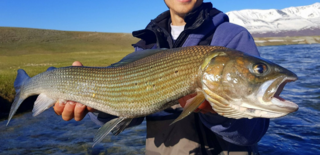
The Amur River or Heilong River is a perennial river in Northeast Asia, forming the natural border between the Russian Far East and Northeast China. The Amur proper is 2,824 km (1,755 mi) long, and has a drainage basin of 1,855,000 km2 (716,000 sq mi). If including its main stem tributary, the Argun, the Amur is 4,444 km (2,761 mi) long, making it the world's tenth longest river.

Thymallus, commonly known as graylings, is a genus of freshwater ray-finned fish and the only genus within the subfamily Thymallinae of the family Salmonidae. Although all Thymallus species can be generically called graylings, without specific qualification the term "grayling" typically refers to the type species Thymallus thymallus, the European grayling.

Thymallus thymallus, the grayling or European grayling, is a species of freshwater fish in the salmon family Salmonidae. It is the only species of the genus Thymallus native to Europe, where it is widespread from the United Kingdom and France to the Ural Mountains in Russia, and Balkans on the south-east, but does not occur in the southern parts of the continent. It was introduced to Morocco in 1948, but it does not appear to have become established there.

The Allier is a river in central France. It is a left tributary of the Loire. Its source is in the Massif Central, in the Lozère department, east of Mende. It flows generally north. It joins the Loire west of the city of Nevers. It is 421 km (262 mi) long, and has a drainage basin of 14,350 km2 (5,540 sq mi).

The Arctic grayling is a species of freshwater fish in the salmon family Salmonidae. T. arcticus is widespread throughout the Arctic and Pacific drainages in Canada, Alaska, and Siberia, as well as the upper Missouri River drainage in Montana. In the U.S. state of Arizona, an introduced population is found in the Lee Valley and other lakes in the White Mountains. They were also stocked at Toppings Lake by the Teton Range and in lakes in the high Uinta Mountains in Utah, as well as alpine lakes of the Boulder Mountains (Idaho) in central Idaho.

The Amur grayling is a species of freshwater ray-finned fish from the genus Thymallus (graylings) of the family Salmonidae, endemic to the Amur basin in Russian Far East and Northeast China and also the Onon and Kherlen basins in Mongolia. It is sometimes difficult to differentiate the species with the Lower Amur grayling. It is seen as a game fish and food fish in Russian Far East and the Chinese Heilongjiang province.
The East Siberian grayling(Thymallus pallasii) is a grayling in the salmon family Salmonidae. Males can reach a size of 44 cm (17 in).
Thymallus yaluensis, also known as Yalu grayling, is a putative species of freshwater ray-finned fish in the genus Thymallus (graylings) of the family Salmonidae. It is endemic to the upper Yalu River on the China-North Korea border.

The Bureya is a south-flowing, left tributary of the Amur river in Russia. It is 623 kilometres (387 mi) long, and has a drainage basin of 70,700 square kilometres (27,300 sq mi). Its name comes from the Evenk word birija, meaning river.

The Selemdzha is a river in the Amur Region of Russia. It is the biggest, left tributary of the Zeya. The length of the river is 647 km. The area of its basin 68,600 km².

The Krivaja is a river in central-northern parts of Bosnia and Herzegovina, and a right tributary of the Bosna River. Its source is confluence of the Stupčanica and the Bioštica rivers at the western outskirts of town of Olovo. From there the Krivaja flows through the scenic gorge between mountains of Zvijezda and Konjuh (mountain), with lot of small mountain streams and small rivers inflow from both sides. Finally, the Krivaja meets the Bosna River in the vicinity of town of Zavidovići.

The Montana Arctic grayling is a North American freshwater fish in the salmon family Salmonidae. The Montana Arctic grayling, native to the upper Missouri River basin in Montana and Wyoming, is a disjunct population or subspecies of the more widespread Arctic grayling. It occurs in fluvial and adfluvial, lacustrine forms. The Montana grayling is a species of special concern in Montana and had candidate status for listing under the national Endangered Species Act. It underwent a comprehensive status review by the U.S. Fish and Wildlife Service, which in 2014 decided not to list it as threatened or endangered. Current surviving native populations in the Big Hole River and Red Rock River drainages represent approximately four percent of the subspecies' historical range.

Bureya Nature Reserve is a protected area (Zapovednik) about 200 km northwest of the city of Khabarovsk, in the Verkhnebureinsky District of Khabarovsk Krai, in the Russian Far East. The territory is one of mountain tundra, rivers and lakes, and taiga forests. It includes the headwaters of the left and right tributaries of the Bureya River, part of the lower Amur River basin. The reserve was created in 1987, and covers an area of 358,444 ha (1,383.96 sq mi).

Thymallus baicalensis, also known as the Baikal black grayling, is a Siberian freshwater fish species in the salmon family Salmonidae.
Thymallus ligericus, the Loire grayling, is a European freshwater fish species in the salmon family Salmonidae. The species is endemic to the upper Loire drainage in France, where it lives in medium to large foothill, canyon and plateau rivers of the mountainous regions.

The Mongolian grayling is a freshwater species of fish of the genus Thymallus endemic to the landlocked rivers in Mongolia, Inner Mongolia Province of China and nearby parts of Russian far east. It is considered to be the largest grayling species in the world, and hence viewed as an auspicious sign by local tribes.

Thymallus svetovidovi, also known as the Upper Yenisei grayling, is a species of freshwater fish in the salmon family. It is found in the upper reaches of the Yenisei River and in western Mongolia.

Thymallus tugarinae, also known as the Lower Amur grayling, is a species of freshwater fish in the salmon family. It is found in the lower reaches of the Amur river on the border of the Russian far east and Heilongjiang Province of China. It was first described in 2007 and is sometimes mistaken for the Amur grayling.















